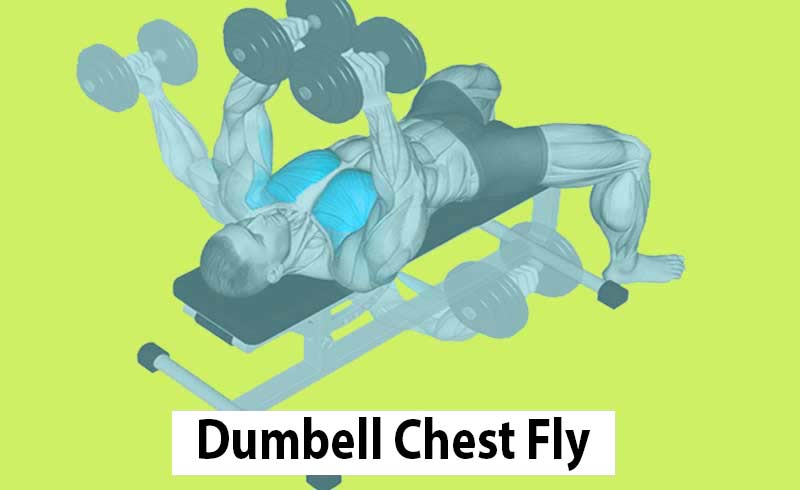In this exercise guide, we’re going to unravel the essential components of a widely practiced movement called the Dumbbell Chest Fly.
You’ll gain a comprehensive understanding of the exercise’s mechanics, uncover tips to optimize your performance, and even explore modified versions (Variations) for added benefits and finally some alterntative exercises with and without machines.
What Are Dumbbell Chest Flys: +The Basics
Before we dive into the details, let’s establish a solid foundation by clarifying a few fundamental aspects.
The Dumbbell Chest Fly is categorized as an isolation exercise, meaning it specifically targets a single group of muscles.
Unlike compound movements that engage multiple muscle groups, such as the barbell bench press, the Chest Fly focuses on developing the chest muscles.
Also, setting up points of contact is essential for a successful chest fly exercise. As you prepare to execute the Dumbbell Chest Flyes, remember to ground your feet firmly, ensuring they’re planted on the floor.
Align your upper back and head with the bench’s surface, while also maintaining contact with the bench through your butt.
This alignment creates a stable base from which to perform the exercise.
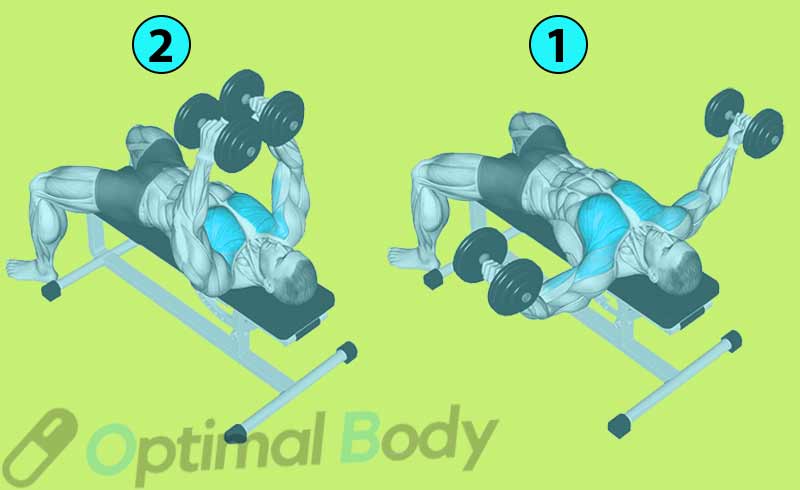
Proper Elbow Positioning:
Now, let’s get into the nitty-gritty of executing the Chest Dumbbell Fly with precision.
The first key factor to master is maintaining the correct positioning of your elbows.
When you start the exercise, ensure your elbows maintain a slight bend, roughly around 10 degrees.
This modest bend is essential as it will stay constant throughout the entire movement.
An important caveat to remember is to avoid any form of elbow movement or bending that might occur during the exercise.
Related Exercise: How To Do Cable Flyes In A Standing Position (ULTIMATE Guide)
Muscles Worked During Dumbbell Fly Exercise:
The dumbbell fly is a versatile exercise that engages a combination of muscle groups to perform controlled arm movements across the chest. Let’s delve into the specific muscles worked during this exercise:
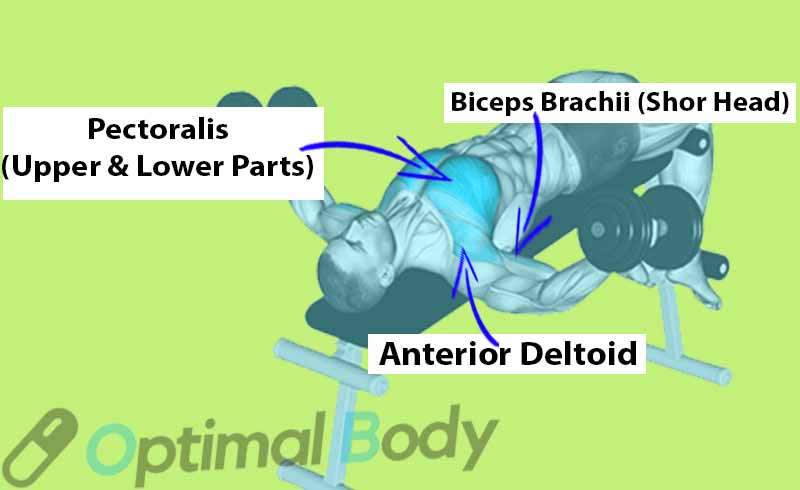
Primary Muscles Engaged:
1. Pectoralis Major:
The pectoralis major, often referred to as the “pecs,” takes center stage as the primary mover during the dumbbell fly.
This twin-set of fan-shaped muscles spans the front of your rib cage. They work vigorously to draw your arms from a wide-open position to the midline of your chest.
The two heads of the pec major play different roles:
- Sternal (Lower) Head: This head is most active during flat or decline bench flys.
- Clavicular (Upper) Head: Engaged primarily during incline-bench flys, focusing on the upper portion of the chest.
Secondary Muscles:
1. Deltoids (Anterior Head):
The anterior heads of the deltoid muscles, located on the front of your shoulders, assist the pectorals in drawing your arms across your chest.
This engagement becomes particularly prominent during incline-bench fly variations when the arm movement occurs at an upward angle.
2. Biceps:
While not the primary focus, your biceps play an essential role in stabilizing your shoulder joint and forearm during the dumbbell fly.
They contract isometrically, meaning they remain static to provide stability as you lower the weights.
3. Rhomboids:
Situated in the upper back, the rhomboids contribute as stabilizing muscles during the dumbbell fly. They help maintain proper shoulder alignment and stability throughout the exercise.
4. Rotator Cuff and Rear Deltoids:
The rotator cuff muscles, as well as the rear deltoids at the back of the shoulders, are engaged to support the shoulder joint’s movement and maintain its stability during the arm motion.
5. Serratus Anterior:
The serratus anterior, a muscle located along the ribs, plays a crucial role in keeping your shoulders in proper alignment.
This muscle’s engagement ensures that your shoulder blades move smoothly and support the overall movement of the exercise.
Dumbbell Chest Flye Common Mistakes:
Two prevalent mistakes are often encountered during the execution of the Dumbbell Chest Fly.
1. Excessive movement of your elbows:
The first involves preventing excessive movement of your elbows, as you extend your arms outward during the dumbbell fly, it’s crucial to keep your elbows from flaring out or bending too dramatically.
2. Wrong wrist alignment:
Secondly, maintaining proper wrist alignment is paramount. Imagine a straight line extending from your elbows to your wrists, This alignment ensures that the dumbbells stay in a stable and controlled position.
3. Improper hand positioning:
Another common mistake is the misplacement of hands, some people end up bringing the weights over their shoulders instead of their chest. This happens due to uncertainty about hand positioning.
4. Not packing your shoulders:
Another common mistake is neglecting to pack the shoulders. Shoulder packing involves retracting your scapula down and back.
Imagine squeezing your shoulder blades together as if you’re trying to pinch something between them.
Many remember to pack their shoulders during bench presses but forget this crucial step during the chest fly.
5. Not differentiating from bench press:
One common mistake is transforming the dumbbell fly into a bench press-like movement.
While the bench presses are effective on its own, it recruits additional muscles, compromising the isolation of the pectoral muscles.
6. Uncontroled repetition speed:
Avoid rushing through repetitions or lifting excessively heavy weights. These practices can lead to significant strain on the shoulder and elbow joints.
Instead, prioritize controlled and deliberate movements.
Step-by-Step How To Dumbbell Chest Fly Guide
You might have come across videos or blogs claiming the dumbbell chest flyes are risky and injury-prone.
Well, here’s the truth: the risk of injury arises not from the exercise itself but from improper execution.
Many people label it as a dangerous move to get more clicks and views, but we’re here to set the it straight.
The Importance of Shoulder Warm-Up First:
Before diving into any exercise, it’s crucial to warm up your shoulders properly.
Your shoulder joints need some TLC to function optimally and avoid unnecessary strain.
Regardless of your workout routine, including squats, take a few moments to warm up those shoulders.
A simple warm-up technique is the shoulder breaker, where you gently move your arms from front to back, this helps to get the blood flowing and prepares your shoulders for the movement.
Dumbbell Flies Instructions:
- Start by lying flat on the bench.
- With your elbows maintaining a slight 10-degree bend, open your arms in a wide arc while keeping your elbow position constant.
- Execute the movement deliberately and with control. As you open your arms, you should feel a gentle stretch in your chest muscles.
- While performing the movement, concentrate on maintaining consistent tension in your chest muscles. Avoid allowing the dumbbells to drop excessively.
- Draw the dumbbells back together, ensuring that your elbows remain beneath your wrists throughout the motion.
- Keep your elbow bend at approximately 10 degrees and concentrate on engaging your chest muscles as you perform the exercise.
Exercise Tips:
- Finisher Movement: Use the chest fly as a finisher at the end of your chest workout to thoroughly target your chest muscles.
- Supersets: Pair the chest fly with your main lift. For instance, superset it with a dumbbell bench press or incline press to maximize your workout’s efficiency.
- Prevent the dumbbells from touching or clashing at the top of each repetition. This maintains a constant tension on the chest muscles.
- Avoid gripping the dumbbell handles excessively tight because over-gripping can unnecessarily engaeges your forearms and biceps, reducing the stimulation of your pectoral muscles.
- Ensure there’s a degree of tension in your abdominal muscles and avoid excessive arching of the lower back. A stable core supports proper posture and movement control.
- Always keep a slight bend in your elbows during the movement. Avoid lowering the dumbbells to a point where you feel discomfort or pressure in the front of your shoulder joint.
Chest Dumbbell Fly Variations
Now that we’ve covered the basics, let’s explore some variations of the Dumbbell Chest Flys that offers additional benefits and safety:
1. The Floor Chest Fly
The Floor Fly provides an added layer of safety, as the floor acts as a safety net.
This setup minimizes the risk of injury if you need to release the weights unexpectedly during the exercise.
A significant advantage of the Floor Fly is the ability to execute an eccentric overload.
This involves focusing on the lowering phase of the movement, which can stimulate muscle growth without straining your shoulders.
How To Do The Floor Dumbbell Fly:
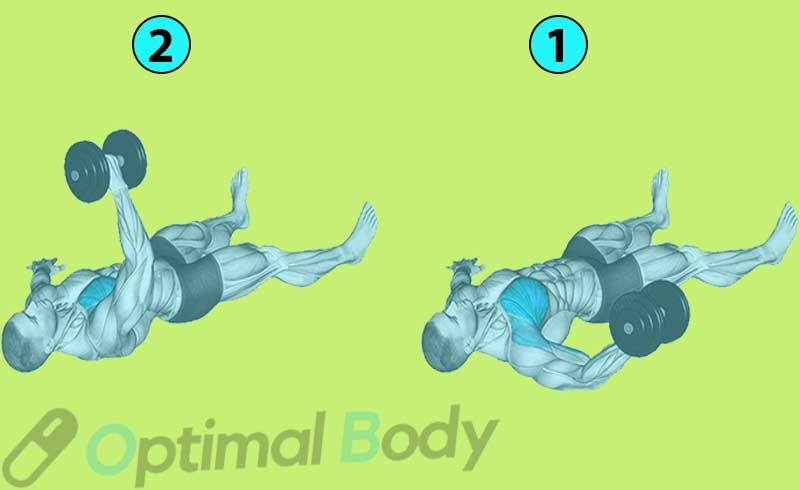
- Lie flat on the floor, ensuring your back, head, and feet are firmly grounded.
- Maintain a slight bend in your elbows as you open your arms wide.
- Do the eccentric phase by lowering the weights slowly and deliberately, creating controlled tension in your chest muscles.
- If necessary, shorten your arm position by bringing your hands closer together. This adjustment will allow you to safely press the weights back up.
- Embrace continuous eccentrics by maintaining a controlled pace and using the safety of the floor to your advantage.
2. Incline Chest DB Fly:
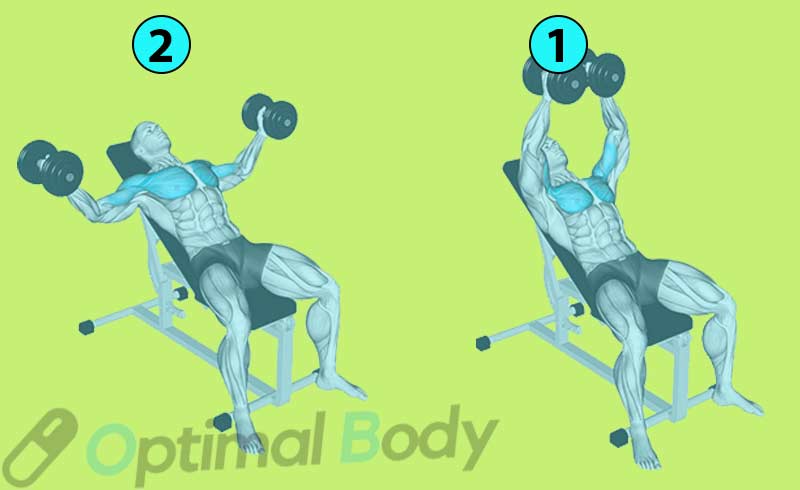
Perform the fly on an inclined bench to shift the emphasis to the upper part of your chest. This variation provides a different angle of contraction and engagement.
3. Flat Around The World Exercise:
The “Around the World” dumbbell flie is an innovative variation designed to optimize chest muscle stretch and contraction. This exercise requires a light weight and is best suited for a flat or incline bench.
How to Perform Around The World Dumbbell Fly:
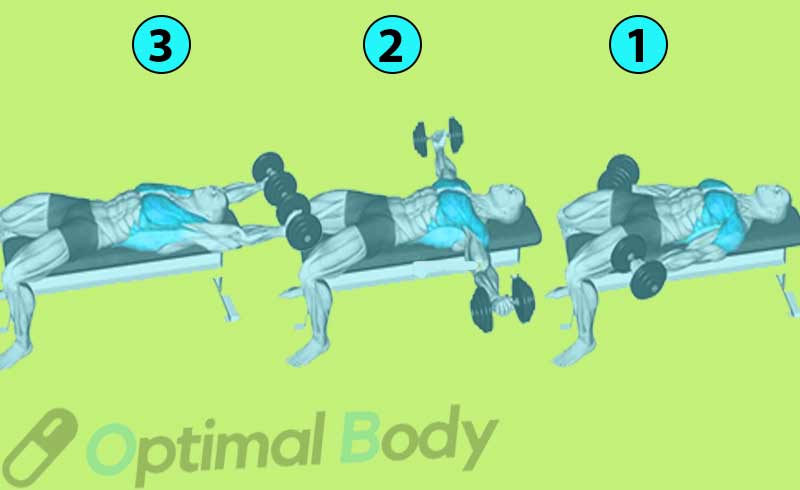
- Begin with the dumbbells positioned overhead.
- Initiate the movement by bringing the dumbbells down and around your sides in a circular motion.
- Contract your pinkies above your waist and your thumbs over your head, creating two distinct contraction points during the exercise.
Focus on achieving a deep stretch of the chest muscles during the downward phase.
Benefits of Around The World Variation:
- Promotes an extended range of motion, enhancing muscle stretch.
- Maximizes muscle contraction by incorporating multiple contraction points.
- Ideal for achieving a full chest muscle activation and a unique training stimulus.
4. Decline Chest Fly:
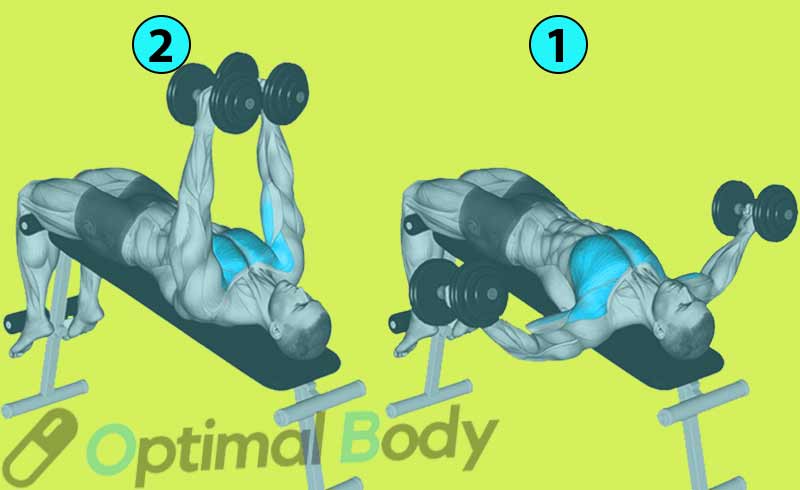
Execute the fly on a declined bench to target the lower part of your chest. This variation is especially effective for hitting the lower pectoral muscles.
5. Overhand/Underhand Chest Dumbbell Fly
Incorporating different grips can significantly enhance the effectiveness of the dumbbell fly.
It is a variation that targets different parts of your chest by alternating between underhand and overhand grips.
How to Do Overhand/Underhand Dumbbell Fly:
- Begin with an underhand grip (palms facing up) and perform a standard dumbbell fly.
- When reaching the top of the movement, transition your grip to overhand (palms facing down) for the next repetition.
- Focus on achieving a strong contraction at the top of each repetition, engaging the chest muscles fully.
- The overhand grip emphasizes the upper chest, while the underhand grip targets the lower and mid-chest areas.
Benefits of Overhand/Underhand Variation:
- Provides targeted stimulation to different areas of the chest.
- Enhances muscle engagement by utilizing varied grip positions.
- Can be incorporated into alternating sets or superset routines.
6. Unilateral DB Fly With Static Hold:
The unilateral fly with a static hold is a highly effective variation that increases time under tension for the chest muscles. It challenges the chest through both contraction and elongation.
How to Do Unilateral Dumbbell Fly With Holds:
- Start with the dumbbells overhead, one arm at a time.
- Lower one arm while maintaining the opposite arm’s position overhead.
- Hold the stretched position on one side as you contract the chest to return the opposite dumbbell overhead.
- Reverse the movement, holding the stretch on the opposite side and contracting the opposite pec.
Benefits of Unilateral Fly With Static Hold Variation:
- Intensifies time under tension for enhanced muscle engagement.
- Emphasizes unilateral training for balance and symmetry.
- Provides a unique finisher for a comprehensive chest workout routine.
Adding these additional dumbbell chest fly variations into your chest workout routine adds diversity and challenges your chest muscles from various angles.
Experimentbwith different grips, ranges of motion, and time under tension strategies to overcome plateaus and speed up your chest development
Effective Alternatives to Dumbbell Fly
If you’re still getting comfortable with the movement or want to ensure safety, there are alternatives to try:
1. Push Ups:
Push-ups are a versatile bodyweight exercise that engages the chest, shoulders, and triceps. They can be variated to target various chest areas by adjusting your hand and body positioning.
Here are two most popular push-up variations:
a. Incline Push-Ups: To emphasize the upper chest, perform push-ups with your hands elevated on a surface, such as a bench or step. This angle places more stress on the upper pectoral muscles.
b. Decline Push-Ups: To target the lower chest, position your feet on an elevated surface while performing push-ups. This angle shifts the focus to the lower part of the pectoral muscles.
2. Cable Chest Fly (Seated):
Instead of dumbbells, use a cable machine to perform the fly. Cables provide constant tension throughout the movement, contributing to continuous muscle engagement.
3. Incline Cable Flys:
If you’re looking to isolate and develop your upper chest muscles, the incline cable fly is an excellent choice.
Utilizing cables instead of dumbbells, this exercise allows for constant tension on the upper chest fibers.
To perform the incline cable fly, set up the cables at an incline angle, with a handle in each hand, open your arms wide while maintaining a slight bend in your elbows.
This variation effectively mimics the incline dumbbell fly while providing continuous resistance.
4. Dumbbell Squeeze Press:
The dumbbell squeeze press is a unique variation that challenges your chest muscles in a different way.
During this exercise, keep the dumbbells in contact with each other at all times.
As you press the dumbbells upward, you actively squeeze them inward, focusing on contracting your chest muscles.
This inward squeeze intensifies the muscle engagement and offers a dynamic way to target the pectoral muscles.
Machine Chest Press: Using a chest press machine offers stability and controlled movement. This alternative can be effective for beginners or individuals looking for controlled resistance.
Dips: Dips target both the chest and triceps. Performing dips between parallel bars or using dip assist machines can provide an effective chest workout.
5. Low Pulley Cable Crossover:
The low pulley cable crossover is a powerful exercise for building substantial pectoral muscles. This exercise targets the upper and inner chest muscles while offering constant tension through the cable system.
Stand between two low cable pulleys, grasp the handles, and with a slight bend in your elbows, bring your arms forward and across your body.
The cable’s resistance helps create stress in the central chest muscles and inner pecs, contributing to well-rounded chest development.
6. Pec Deck Machine (Seated Machine Fly)
This machine chest workout mimics the chest fly motion and provides a consistent resistance profile. It’s a great alternative for beginners or those seeking controlled muscle activation.
The seated machine fly is an excellent alternative to the traditional dumbbell fly.
It effectively targets the chest muscles and provides a controlled range of motion.
To do the seated machine fly, sit down on the machine and grasp the handles. With your elbows slightly bent, open your arms outward while squeezing your chest muscles.
Single-Arm Dumbbell Press: This exercise involves pressing a single dumbbell while lying on your back. It engages your chest and stabilizer muscles, providing an effective variation.
References & Resources:
- Schoenfeld BJ, Contreras B, Krieger J, Grgic J, Delcastillo K, Belliard R, Alto A. Resistance Training Volume Enhances Muscle Hypertrophy but Not Strength in Trained Men. Med Sci Sports Exerc. 2019 Jan;51(1):94-103. doi: 10.1249/MSS.0000000000001764. PMID: 30153194; PMCID: PMC6303131.
- Solstad TE, Andersen V, Shaw M, Hoel EM, Vonheim A, Saeterbakken AH. A Comparison of Muscle Activation between Barbell Bench Press and Dumbbell Flyes in Resistance-Trained Males. J Sports Sci Med. 2020 Nov 19;19(4):645-651. PMID: 33239937; PMCID: PMC7675616.
- Bench Press Calculator - April 22, 2024
- Press to Handstand: Ultimate Step-by-Step Guide - April 22, 2024
- Cable Press (How To Do, Benefits, Targeted Muscles, Alternative) - April 22, 2024

